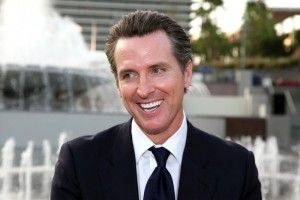Gov.-Elect Newsom’s interest in tax reform likely to face bipartisan push-back
by Chris Reed | November 26, 2018 3:00 am

Governor-elect Gavin Newsom says he hopes[1] to amend the California tax code to lessen its dependence on income and capital gains taxes paid by the very rich. Yet the last two serious attempts at tax reform were both dead on arrival, and the political dynamics since their failure appear unchanged or even more unfavorable.
With the state overdue by historical standards for another recession, Newsom is well aware of the revenue nightmare that is looming. After the Great Recession hit a decade ago, state revenue plunged nearly 20 percent – leading to harsh budget cuts in education, public health and social services. Since income and capital gains taxes generate about two-thirds of state revenue, volatility[2] is common.
The revenue decline a decade ago led then-Gov. Arnold Schwarzenegger to create a commission[3] that in 2009 recommended slashing taxes on income and capital gains while imposing taxes on broad categories of services including legal work, haircuts and tickets to sports and entertainment events. The goal was a tax code rewrite that was initially revenue-neutral but that could end up creating considerable new revenue because of provisions designed to promote economic growth.
Democrats see income-tax cut as gift to rich
Yet while commission heavyweights like former Treasury Secretary George Shultz and many economists touted the wisdom of the proposal, the commission’s tax-overhaul blueprint was blasted by both parties from the moment it was released.
Democrats said the plan was a giveaway to the rich. Republicans knocked it for expanding government taxation to new areas.
The scheme – dubbed the Parsky plan because Rancho Santa Fe GOP businessman Gerald Parsky chaired the commission – never even came up for a committee hearing.
Six years later, in 2015, state Sen. Robert Hertzberg pushed a similar proposal[4], but with a twist. Instead of being revenue-neutral, has plan would yield $10 billion in new revenue a year. Yet Hertzberg’s plan was also DOA in the Capitol for the same reasons as Parsky’s.
Now, with the progressive wing in more complete control than ever of Democrats, their antipathy toward the idea of tax relief for the rich may never have been stronger. That was reflected in the recent Sacramento Bee story[5] about Newsom’s interest in revamping the state tax code.
Jessica Bartholow, policy advocate at the Western Center on Law & Poverty, told the Bee that the tax code shouldn’t be changed to help the rich and big business.
“Capital gains is money earned by people who didn’t earn it,” Bartholow said. “If wealthy corporations and people are having an upswing in their interests, then why shouldn’t the poorest people?”
Republicans fear reform would prove bait-and-switch
The strongest voice in support of tax reform the Bee cited was Rob Lapsley, president of the California Business Roundtable. But the basic sentiment conservatives expressed about the Parsky and Hertzberg plans – Sacramento wants to tax even more human activities? – is at least as intense as in 2009 and 2015. There is considerable suspicion that any reform plan would end up as a Trojan horse for much higher taxes.
This is fueled by evidence that Democrats are gearing up for a huge push to hike taxes even though state revenue is at an all-time high. The most high-profile gambit is qualifying a measure[6] for the 2020 ballot that would end Proposition 13 protections against property tax hikes of more than 2 percent a year for commercial and industrial properties.
This tax-hike fervor is already evident in local governments, including some under Republican control. As CalWatchdog reported last month, more than 150 local governments asked voters [7]to raise taxes in the June and November elections. While most of the tax hikes were adopted after campaigns depicting them as crucial to public safety and to maintaining government services, by far the fastest-growing category of local spending is on pension[8] costs, which are predicted to roughly double for California cities from 2015 to 2025.
- hopes: https://www.sacbee.com/news/politics-government/capitol-alert/article221751020.html
- volatility: https://lao.ca.gov/reports/2017/3548/Volatility-of-PIT-030817.pdf
- commission: http://www.cotce.ca.gov/about/
- proposal: https://sd18.senate.ca.gov/news/1222015-san-diego-union-tribune-will-needed-state-tax-reform-plan-be-hijacked
- story: https://www.sacbee.com/news/politics-government/capitol-alert/article221751020.html
- measure: http://www.counties.org/csac-bulletin-article/property-tax-initiative-split-roll-qualifies-2020-ballot
- asked voters : https://calwatchdog.com/2018/10/29/more-than-100-local-governments-seek-tax-hikes-to-meet-rising-pension-bills/
- pension: https://www.sandiegouniontribune.com/communities/south-county/sd-se-chula-vista-budget-20180425-story.html
Source URL: https://calwatchdog.com/2018/11/26/gov-elect-newsoms-interest-in-tax-reform-likely-to-face-bipartisan-push-back/